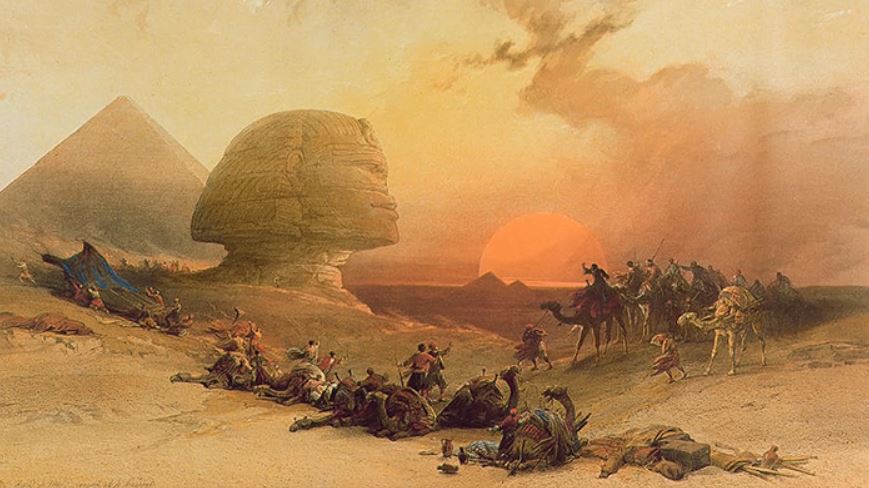The Egyptian Pyramids and the Great Sphinx have always aroused the curiosity of spectators due to the complexity of their construction and the fact that they have survived thousands of years. For some years now, a debate has erupted between mainstream and alternative archaeologists over the age of these monuments. For some scholars of occult history, these buildings were not erected in ancient Egypt, but many thousands of years earlier, by an unknown civilization. They even claim to have found evidence that the Sphinx was once submerged underwater.
The Pyramids and Sphinx of the Giza Plateau are possibly thousands of years older than researchers suggest. In fact, these ancient structures could predate the ancient Egyptian civilization by thousands of years. Many researchers indicate that there is sufficient evidence to suggest that the Giza Plateau was severely damaged in the past.
Interestingly, given the evidence found on the Giza Plateau, the Sphinx and the pyramids could be some of the megalithic structures that survived the Great Flood. Researchers suggest that the Sphinx, the Temple of the Sphinx, and the first 20 layers of the Great Pyramid of Giza suffered erosion due to deep water saturation.
Much has been said about the Great Pyramid of Giza and its mysterious companion, the Great Sphinx of Giza. Although we still have absolutely no clue as to who erected the Great Pyramid of Giza and who carved the Sphinx, numerous theories have been proposed attempting to explain two of the most mysterious structures ever built on the surface of the planet.
“While many questions remain unanswered about the Great Pyramid of Giza, we remain perplexed by the complexity and precision of these incredible ancient structures thousands of years after their creation,” said Ivan Petricevic.

Were the Great Sphinx and the Pyramid of Giza submerged underwater?
Today, there are many more questions than answers about the Great Pyramid of Giza . How is it possible that, thousands of years ago, people managed to transport enormous blocks of stone and incorporate them into one of the most enigmatic ancient structures on Earth?
But perhaps the greatest mystery is how ancient humanity managed to align the Great Pyramid of Giza so precisely. The Great Pyramid of Giza is the most precisely aligned structure on Earth. The position of the North Pole shifts over time, and the pyramid was aligned at exactly the same time. Furthermore, the Great Pyramid sits at the center of the Earth ‘s mass .
The east/west parallel, which crosses most of the Earth, and the north/south meridian, which crosses most of the Earth, intersect in two places on Earth: one in the ocean and the other at the Great Pyramid.
However, all of the above is not as impressive as the traces of water erosion found on the Giza Plateau. Apparently, the entire Giza landscape, including the Pyramid and the Sphinx, shows signs of erosion, suggesting that in the distant past, these magnificent ancient structures were submerged under water. Dr. Robert M. Schoch was one of the first researchers to really address the theory that the plateau structures are much older than previously thought.
In the early 1990s, Dr. Schoch suggested that the Sphinx was built thousands of years older than archaeologists believed , dating it to between 5,000 and 9,000 BC. This suggestion is based on the pattern of water erosion found on the monuments and the surrounding rocks.

Dr. Robert M. Schoch
However, Dr. Robert M. Schoch is not alone in suggesting that we are looking at evidence that these ancient structures were once submerged. Archaeologist Sherif El-Morsi suggests that the Giza plateau, which was once flooded by a tidal surge, may have been an ancient lagoon at the time when sea level covered the Necropolis, the Sphinx, the temple complex, and other monuments in the area.
Morsi said in an article published on the Gigal website :
“During one of the documentations of the old line, I almost tripped over a block from the second level of a temple. To my surprise, the protrusion on the top surface of the block that almost tripped me over was, in fact, the exoskeleton of a fossil of what appears to be an echinoid (sea urchin), which are marine creatures that live in relatively shallow water.
Archaeologist Morsi believes the flooding was very significant, peaking at around 75 meters above current sea level and creating a coastline encompassing the Khafra enclosure near the Sphinx at the Menkaure temple. Morsi also suggests evidence present in the monuments and surrounding blocks indicating the presence of tsunamis in the past, and even suggesting an intertidal zone of about two meters.
The mystery of the Great Sphinx

The mystery of the Great Sphinx
Two Ukrainian scientists, who presented their study at the International Conference on Geoarchaeology and Archaeomineralogy held in Sofia, entitled: Geological Aspect of the Problem of Dating the Construction of the Great Egyptian Sphinx, suggest that the Great Sphinx of Giza is hundreds of thousands of years old and shows clear evidence of erosion caused by water.
According to Manichev and Parkhomenko:
«The problem with the construction of the Great Egyptian Sphinx remains valid, despite the long history of its investigations. The geological approach, in conjunction with other natural-scientific methods, allows us to answer the question about the relative age of the Sphinx. The visual investigation carried out on the Sphinx allowed us to conclude about the important role of water, of large bodies of water that partially flooded the monument, forming wave-cut hollows in its vertical walls.»
Manichev and Parkhomenko firmly believe that the Sphinx must have been submerged underwater for a long time, and to support this hypothesis, they point to the existing literature on geological studies of the Giza Plateau. According to Manichev and Parkhomenko, it was the sea level during the Calabrian phase that is closest to the current peak, with the highest Giza depth.
The high sea level also caused the Nile to flood, creating long-lived bodies of water. The time period corresponds to 800,000 years. While many people strongly oppose the theories put forward by Manichev, Parkhomenko, and Schoch, others firmly believe that the magnificent monuments located today on the Giza Plateau are the last evidence of pre-Flood monuments, built by a completely different civilization that predates the civilization that inhabited the land of the pharaohs, possibly even before the “Great Flood” that is described in numerous ancient texts by different cultures.
While many people oppose the idea that there was a great flood on Earth, researchers estimate that over the past 140,000 years, sea levels have fluctuated by more than 120 meters in different parts of the world. Interestingly, Robert Ballard, one of the best-known underwater archaeologists who, in 1985, used a robotic submersible with a remote-controlled camera to locate the famous wreck of the Titanic, probed the depths of the Black Sea near the coast of present-day Turkey in search of traces of ancient civilizations dating back to the time of Noah, indicating that the great biblical flood mentioned in ancient Sumerian texts was real.
Ballard even established a chronology of events using carbonate shells found along the ancient coastline. Ballard estimates that the catastrophic flood occurred around 5,000 BC, a date that many scholars believe is the date on which Noah’s historical flood took place.
Sphinx, Pyramids and the Great Flood

Evidence has been found that the Great Sphinx was submerged.
The story of a ” Great Flood ” sent by God (or gods, according to earlier accounts) to destroy humanity for its sins is a widespread tale shared by many religions and cultures around the world, dating back to our earliest recorded history.
From India to ancient Greece, Mesopotamia, and even among the Native American tribes of North America, there is no shortage of tales that often sound the same. Some of these stories actually sound so similar that one might wonder if every culture around the planet had experienced such an event.
Could it be that all the flood stories so zealously repeated around the world are a collection of myths or isolated incidents, as mainstream scholarship maintains? Or was the Great Flood a single global cataclysm that affected all of humanity at a time in our prehistory? While small, isolated disasters can both stress and frighten affected populations, their overall effect is short-lived, often fading from memory within decades, if not years.
In the case of the Great Flood, however, we have a history that seems boundless, one that every culture insists is global in nature. Yet how vast and destructive must such a disaster have been, to have managed to permeate the collective memory of our ancestors for thousands of years? Judging by the shared testimony, this must not only have been an event that affected everyone simultaneously, but for it to have become a permanent fixture in the human psyche, it must have been an experience that persisted not just for days or months, but for several generations.
Based on all the above, it’s not difficult to wonder if it’s possible that the magnificent Pyramids of Guise and the Great Sphinx were in fact built before the Great Flood, by a very ancient civilization, predating even the earliest Egyptian records. Perhaps they were built even before Egypt was a desert, and even before the beginning of humanity as we know it, and perhaps by civilizations from other worlds.



